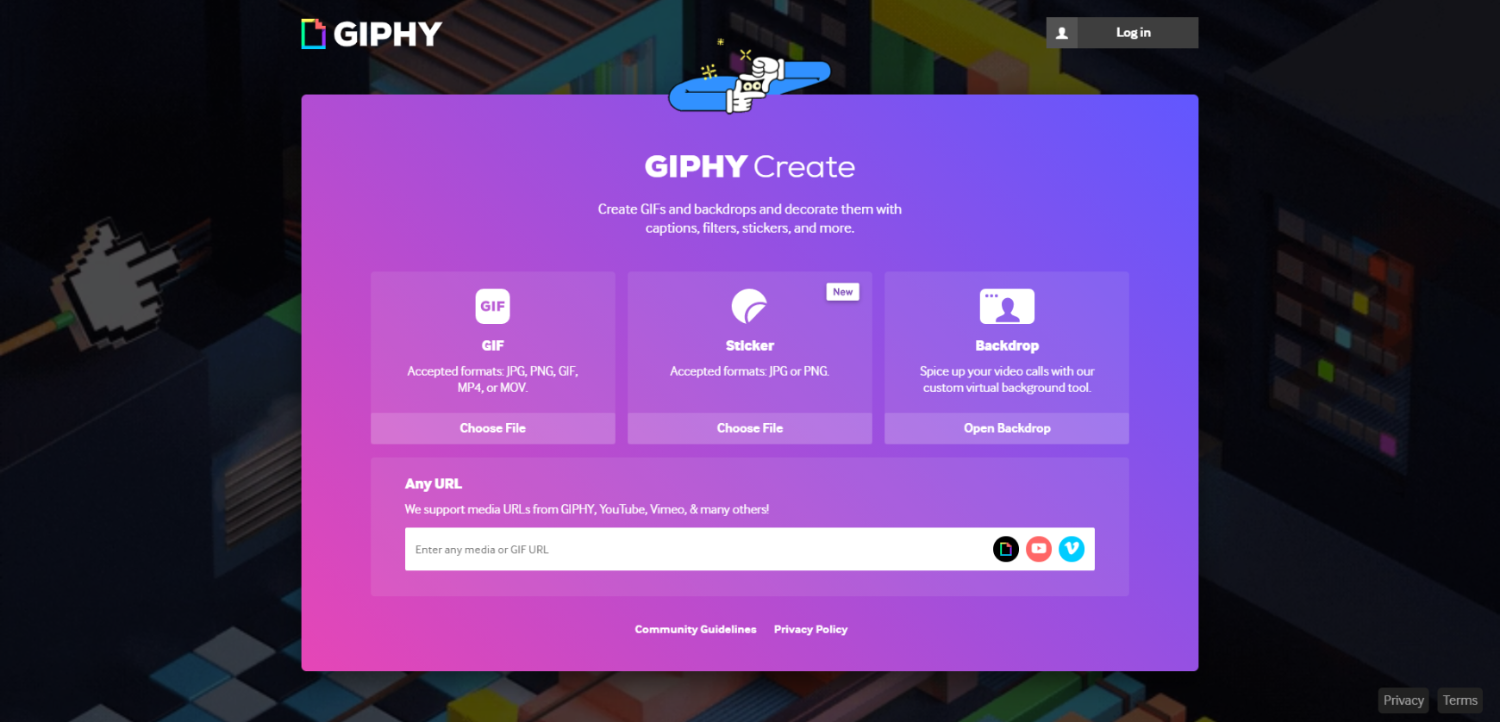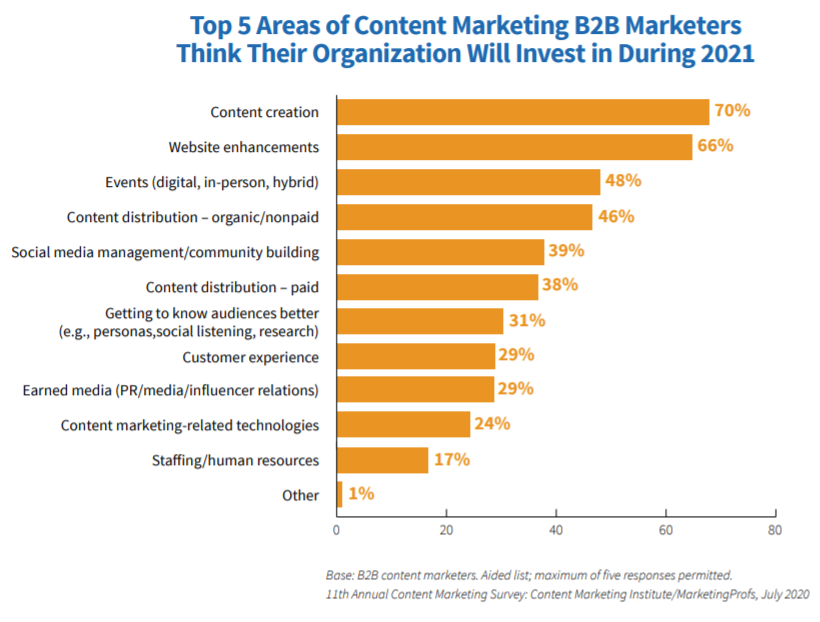24 Mar 5 Big Content Trends You Need to Know Now via @JuliaEMcCoy
Content marketing and SEO have been hitting some awesome high notes.
We’re careening toward a bright future of more useful, helpful, technically amazing content that aligns with user habits, preferences, and search needs.
Content is getting better because we’re getting smarter about how we strategize, research, create, and publish it.
And as a result, content marketing is no longer some type of marketing experiment, but a proven strategy that can work for any brand.
So what’s next for content? Let’s dive in.
1. Next-Level Visuals in Content
Visually-forward platforms will continue to be trendy now and in the future.
From entertainment to communication, people are going all-in on the power of dynamic or interactive imagery.
Among the next generation of soon-to-be-adults, visual social media reigns supreme.
Instagram, TikTok, and Snapchat are the most popular platforms where teens hang out.
For adults, YouTube is the most-used platform, topping even Facebook.
To this end, visuals in content are only going to get more interesting and appealing to users.
For instance, did you know you can create your own augmented reality (AR) filters and lenses for Snapchat? (There are even creators you can hire to do it for you.)


Let’s not forget Instagram AR filters. You can create your own for Stories.
Another trend: Creating your own GIFs from video clips via Giphy.
Instead of pulling a reaction GIF from your favorite movie, TV show, or character, now you can GIF yourself.


The possibilities are endless.
Now and in the future, we’ll be seeing more marketers taking advantage of dynamic, custom, branded imagery for their content.
2. Video Content & Visual Storytelling
For the past few years running, video has been a big deal.
With the popularity of YouTube, dynamic imagery, and AR, video content and visual storytelling are set to continue their meteoric rise.
A consumer preference for video content is showing up across the board – even inside Instagram Stories.
- According to a study by Socialinsider, the tap-forwards rate (the number of people who tap their screens to advance to the next piece of content in their feed) is about 5.65% higher for images than for videos. That means more people stop and watch video Stories all the way through.
- The tap-forwards rate for images is even higher for brands with larger followings: 5.79% for accounts with 10k – 100k followers, and 6% for accounts with over 100k followers.


There’s also a preference for video in marketing:
- Wyzowl’s State of Video Marketing report found 84% of people have been convinced to buy a product/service through watching a video. Another 79% said watching a video convinced them to download an app or software.
- From the same survey, 69% said they’d prefer to watch a short video to learn about a product/service. For comparison, only 18% would prefer to read a text-based article, the next-popular choice.
- According to a HubSpot survey of over 3,000 consumers, 56% of 25-34-year-olds and 54% of 35-44-year-olds want to see more video content from brands they support.


Finally, let’s not forget that YouTube is the second-most-popular search engine (only behind Google).
Also, 1 in 2 Millennials and Gen Z-ers say they “don’t know how they’d get through life” without video.


What does this all mean for marketers?
As consumer habits and preferences continually move to video content, we have to keep up or get left in the dust.
Of course, what sets apart successful video content from the stuff that gets five total views is the quality of the storytelling.
You have to be able to engage readers through any medium, including video.
If you can tell great stories, you’re halfway there.
3. Upping Your E-A-T
A few years ago, Google published a blog on Webmaster Central with reminders about its core updates and what to do about them.
Specifically, the blog recommended an action a lot of us have already been doing: Reading/understanding the Search Quality Rater Guidelines and E-A-T (Expertise, Authoritativeness, Trustworthiness).


The fact that Google specifically pointed to this resource and singled out E-A-T is a huge hint. We all need to be focused on proving expertise, authority, and trust in our content.
That applies to both websites as entities representing a specific brand or organization, and to individual authors writing content on those websites.
How do you prove your E-A-T?
- By earning links or mentions from other authority websites.
- By providing E-A-T information on your site, including a bio and credentials on your about page and author pages.
- Linking out to authoritative sources for supporting stats, data, and facts in content.
- Updating your site and content regularly with relevant, accurate, current information.
On top of that, your content must be exceptional. Well-crafted, user-beneficial, purposeful content backed by E-A-T can’t lose. (More on that straight ahead.)
4. Better, More Purposeful Content Than Ever Before
The need for stellar, purposeful content won’t stop — not now, not in the future.
More and more creators and marketers understand the need for content of the highest quality:
- 70% of marketers predict their top area of investment will be content creation, according to Content Marketing Institute’s B2B report.
- Investment in and use of content creation/workflow technologies increased by 10% over 12 months.
- 86% of B2Bs outsource content creation.


Marketers are understanding you need better content to win in the SERPs and with readers.
In fact, ranking for competitive key terms will only get harder when everyone is bringing their A-game.
That means we’ll continue to see the following from brands of all sizes:
- A better understanding of what the target audience needs from search results for a given keyword.
- Better writing tailored to audiences, with consistency for the brand’s tone and style.
- Better research, including more current stats and data from reputable sources.
- More depth and deep exploration of topics.
- Better visuals, such as branded imagery, infographics, and custom blog images.
Although it’s going to be harder to rank, more people will be creating better content.
That means fewer of us will be adding to the crap content garbage heap. I call that a win.
5. Ultra-Targeted, Customer-First Content
Customer-first, user-first content isn’t just a trend – it’s how you win with both audiences and search engines.
In fact, 88% of the most successful B2B marketers say they prioritize their audience over their own sales/promotional message.


They understand that trust-building with audiences begins with offering guidance, help, information, or entertainment without a catch.
More than that, the very best content that hits the user’s needs in the bullseye is the type that will rank #1 with Google.
This will continue to be a trend because it works.
How do you find out what your unique audience needs from your content?
Research.
Asking questions. Engaging with the community. Discovering who they are.
Once you know them intimately, you can create content that speaks to them on a deeper level. In a nutshell, that’s ultra-targeted content.
It puts the audience first – in some cases, the niche-niche audience. It nails their user search intent. It serves a purpose and fulfills an information need.
That’s the kind of content Google is prioritizing now, and it’s what we need to focus on for the future.
The Future of Content Is Here
Content’s future has arrived, and it has never looked so good.
More marketers than ever are prioritizing quality and the customer’s information needs over sales messages. We’re focused on building trust and authority with authenticity, not sales tricks.
On top of that, visual media is going in startlingly new and exciting directions. The possibilities for integration with content are crazy-good.
Going forward, watch for innovative marketers to push the boundaries of content creation.
Look for ultra-targeted content, more commitment to a customer-first approach, and overall, better content flooding the scene.
I don’t know about you, but I can’t wait.
More Resources:
- 5 Trends to Know in SEO & Content Marketing
- Content Marketing: The 5 Most Important Things You Need to Know
- Content Marketing KPIs: Your Guide to Picking the Right KPIs for Content
Image Credits:
All screenshots taken by author, March 2021
Sorry, the comment form is closed at this time.